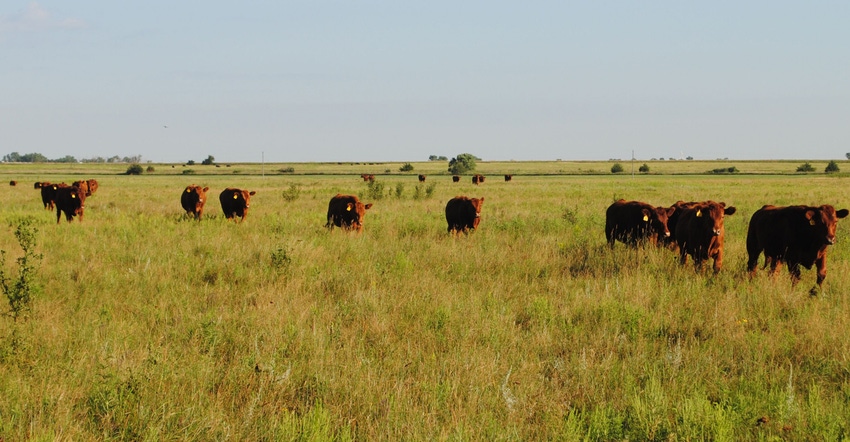
Beef producers are searching for ways to boost their bottom lines without giving up on production or hurting herd health. Nebraska Extension educator Gary Stauffer in O'Neill came up with a checklist of 13 profitable practices beef producers can take advantage of to help push forward through tougher financial times. He talked about these points at a recent Beef Profit Tips workshop in Center. Here are practices on Stauffer's checklist.
Match cow size to your resources. "The more milk they give, the more feed they need," Stauffer said. "Even dry cows that are high-milking have high maintenance requirements." Cow size should match forage resources, especially as the cost of pasture and feed continue to rise.
Set calving time in synch with Mother Nature. "You feed more supplement and harvested feeds when you calve early," Staffer said. "It's easier to gain body condition in the spring compared to the winter, because cows can gain condition easier on grass." Finding labor at calving time has been a greater challenge for ranchers, so later calving can also save on the need for additional labor.
Wean early during drought. Multiple studies have shown that it is cheaper to feed calves than to feed cows to feed the calves. Studies at the UNL Gudmundsen Sandhills Laboratory found that producers can save up to 10 pounds of forage for each day a calf is weaned early. However, producers need to stay on top of health challenges with lightweight, early-weaned calves, Stauffer said.
Age- and source-verify calves. There is very little cost involved in getting calves age- and source-verified, but it can mean premiums of up to $2 to $3 per hundredweight on each calf sold. In many cases, information from a calving record book is enough to participate in a program.
Select genetics and market calves toward a grid. "If you hit the right grid, you could obtain up to $200 per head in premiums," Stauffer said. "The trick is to figure out what kind of cattle you have and what grid will pay the best for that type of cattle." More and more fed cattle are being marketed and paid on carcass value, so it is beneficial to ranchers to breed to fit these premium-based grids.
Rotate grazing and increase stocking density. "Continuous grazing won't pay for the rising cost of land," Stauffer explained. "Rotating pastures and grazing is almost a no-brainer if you want to make money." Stocking rates can go up and rotational grazing, including modern mob grazing of up to 1 million pounds of beef per acre for short periods, can also increase production from range.
Use crossbreeding. "I'm seeing more and more Hereford bulls with black cows," Stauffer noted. "Those black baldy cows we were used to seeing as a result were good cows. There is a small number of AI sires being used today, so we've lost some of the vigor that comes from crossbreeding," he said. "We know that crossbreeding will help calves put on extra pounds, improve feed efficiency, have better reproductive performance and more longevity in the cows." If you are not using crossbreeding, you should then be getting a premium for straight-bred calves.
Balance selection for traits. "Many traits are antagonistic to one another, so if you gain on one, you lose on another," he said. "Keep your selection criteria balanced. You will probably need to keep replacement heifers from what you produce, so look at maternal traits if you are keeping heifers."
Semen-test bulls and pregnancy-check cows. Up to 8% to 10% of bulls don't pass a semen check, and 15% to 20% of yearling bulls fail the test, Stauffer said. You can't afford to turn a subfertile bull out with your cows. Pregnancy-checking cows provides options to the rancher for feeding and marketing cull cows. "In 2010, 15% to 35% of heifers and 10% to 30% of cows were open. That was the worst year," Stauffer said. "Normally, it might be 10% open on heifers and 5% to 8% on cows."
Use ethanol co-products. "Co-products are high in protein and energy," Stauffer said. "The energy is even better than corn." It was once thought that producers couldn't store co-products for long, but studies have shown that this isn't the challenge we once thought. Both distillers grains and corn gluten feeds provide high fiber energy with high digestibility.
Use crop residues. Long-term studies have shown yield improvements on subsequent crops after cattle have grazed cornstalks. Not grazing crop residues is actually wasting a valuable resource, and compaction concerns because of grazing have been overestimated, Stauffer said. "Baled cornstalks can also work, but this takes many nutrients off the field and reduces organic matter," he added.
Monitor depreciation and feed costs. Feed costs are No. 1, but with high cow prices, depreciation can cost producers. "Longevity of cows can help offset high depreciation," Stauffer said. "That's why in Argentina they actually fit old cows with only a few teeth with new teeth, to get a few more years of production," he explained. "And they don't put up with any open cows there."
Minimize borrowed money and unnecessary investments in machinery. Shiny new equipment looks good in the shed, but seldom makes any money, Stauffer noted. "Keep investments low in things that rust, rot or depreciate," he said. "It's OK to borrow money for things that will make you money; but if not, interest on borrowed money will steal from your bottom line."
You can learn more profit tips from Stauffer by contacting him at [email protected].
About the Author(s)
You May Also Like






